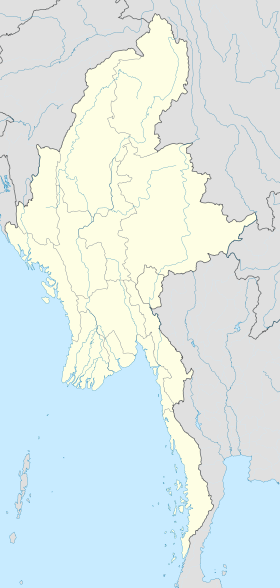- Tedim
-
Tedim Administration Pays  Birmanie
BirmanieÉtat État Chin Géographie Coordonnées Localisation Tedim, ou Tiddim pour les britanniques, est une ville de l'État Chin, au nord-Ouest de la Birmanie. A l'époque britannique, elle était capitale de district. C'est aujourd'hui une grosse ville tranquille, situé sur un plateau difficile d'accès, dans une région très montagneuse.
Sommaire
Histoire et légende
En l'absence d'écriture, l'histoire de la ville est seulement connue par tradition orale. Elle aurait été fondée vers 1600 par Gui Mang, un prince Zomi de la puissante famille des Guite, qui régnait alors dans la région[1]. Selon la tradition, le nom "Tedim" est dérivé d'un lac au sommet des collines, qui scintillait au soleil : te signifie "brillant" et dim "scintillant" en dialecte Paite[2]. Cependant, il existe deux princes Gui Mang dans la chronologie locale, et le fondateur de Tedim est peut-être Gui Mang II[3].
Après la mort de Gui Lun (cinq générations après Gui Mang II), Tedim fut abandonnée pour deux générations. Elle redevint ensuite le centre politique des Guite[4] Il existe une chanson commémorative de Pum Go à ce sujet (début du XVIIIe siècle) :
-
- Dimtui vang khua, khua munnuam aw, sial leh sawm taang a tunna,
- Sial leh sawm taang a tunna, siing tan’ lam bang eng nah e;
- Taang silsial e, taang silsial e, Dimtui vangkhua taang silsial e,
- Dimtui vang khua taang silsial e, kawi tawh laukha ka hualna.
En français :
-
- Ma Dimtui (nom poétique de Tedim) natale est un endroit délicieux, où tous mes vœux sont accomplis,
- Où tous mes vœux sont accomplis, car tout est verdoyant et net ;
- Elle brille, oui, elle brille, ma Dimtui natale brille secrêtement,
- Ma Dimtui natale brille secrêtement, là où j'ai juré fidélité à ma bien-aimée C'est-à-dire : où je l'ai épousée.
A l'époque de Mang Suum II, fils de Pum Go, les forces des Pawihangs (Pois ou Pawi) envahirent subitement la région et Tedim fut à nouveau abandonnée par Mang Suum et les siens, même si certains habitants survécurent sous la domination de Mang Gin, de la famille Hatlang[5]. En 1840, les habitants restants appelèrent à l'aide Kam Hau, de la famille Sukte, nouvelle puissance montante liée militairement et politiquement avec les Zahau (sous-groupe des Pawis)[6].
Sous Kam Hau, Tedim retrouva la sécurité et devint le centre politique et commercial de la région[7]. Ce serait la raison pour laquelle les britanniques la choisirent comme résidence de leur officier de district.
Le 89e bataillon d'infanterie de l'armée birmane posséderait un laboratoire de fabrication d'héroïne à Tedim[8].
Dialectes
Tedim est aussi le nom d'un dialecte Mizo-kuki-chin parlé dans la région, ainsi que dans certaines parties des états indiens du Manipur et du Mizoram. Le nombre total de locuteurs Tedim serait de 350 000.
Le Tedim est étroitement apparenté au dialecte Paite du Manipur. Ses locuteurs sont appelés Chin mais préfèrent généralement le terme Zomi. Ils célèbrent le 20 février comme le Zomi Nam Ni (Jour National Zomi, appelé par les autorités Jour National Chin).
Liste des tribus
Par ordre alphabétique :
- Anlangh
- Cikha
- Gamlai
- Gawngmual
- Haicin
- Laitui
- Lamzang
- Ngennung
- Ngente
- Thangnuai
- Tonzang
- Tuithang
- Tuituum
- Vangteh
Notes
- C. Thang Za Tuan, Prof., "Zomi Tanchin Tomkim," in Zolus Journal 4 (1999): 3-6. Dr. Tuan is a retired Deputy Director General of Basic Education Dept., the Ministry of Education, Myanmar. He dated 1570 to be the first founding of Tedim by Gui Mang.
- TEDIM BEHS NO 1 GOLDEN JUBILEE MAGAZINE (Tedim, Chin State, Myanmar: Magazine Committee, 1998). This is a commemorative magazine of the Golden Jubilee of the school.
- Cf., genealogical chart under "Guite" in Khup Za Thang, Capt. K. A., Zo Suan Khang Simna Laibu: the Genealogy of the Zo (Chin) Race of Burma (Parague, 1972).
- Gin K. Thang, com., Guite Khang Tangthu, (Kalemyo, Myanmar: 1986). This local publication was once reverted by the compiler in 1994, for the mis-inclusion of an illegitimate name called Gui Luah (Guiluah). However, apart from this single weakness, this local publication is still the best collection of existing oral accounts on the Guite dynastic rule.
- C. 1820, by C. Tuan.
- Sing K. Khai, Zo People and Their Culture (Lamka, Churachanpur, India: Kampu Hatzaw, 1995), 25-27 [Khai well comments the emergence of the Sukte family as a matter of fear of the Pawis of present Falam, that Khan Thuam and his son, Kam Hau, ruled as their vassel].
- Sukte Beh leh Tedim Gam Taangthu (Tedim, Myanmar: Laibu Bawl Committee, 1993). This is also a local publication of a collection of the oral accounts of the Sukte dynastic rule.
- (en) Burma's Drug Situation, Canadian Friends of Burma, août 1999 — consulté le 9 octobre 2010 —
Liens externes
- (en) Cet article est partiellement ou en totalité issu de l’article de Wikipédia en anglais intitulé « Tedim » (voir la liste des auteurs)
-
Wikimedia Foundation. 2010.

